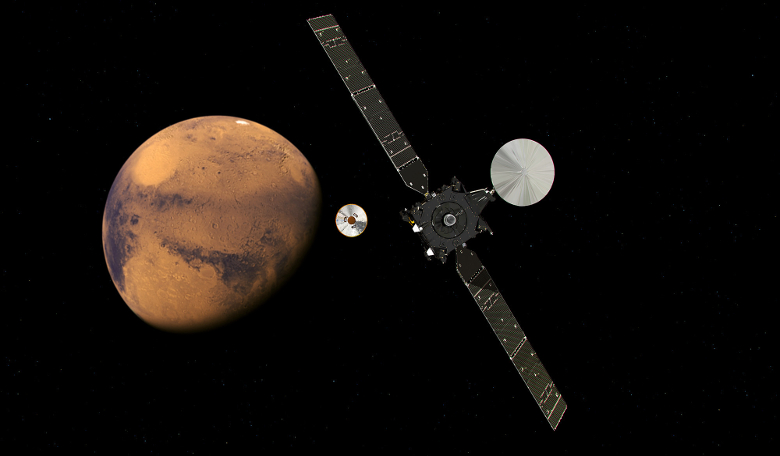It’s all systems go, as ESA’s ExoMars spacecraft, currently in orbit around around Mars, is undergoing necessary manoeuvres before its Schiaparelli unit enters the martian atmosphere in two days time.
Schiaparelli is the missions Entry, Descent and landing demonstrator Module (EDM) and it has already separated from the Trace Gas Orbiter (TGO) yesterday at 16:42 CEST (14:42 GMT) as planned.
This morning however, it was the turn of the TGO to complete an orbit raising manoeuvre, as without the manoeuvre, the spacecraft would, like Schiaparelli, crash headlong into Mars.
The Trace Gas Orbiter will monitor the UHF transmission from Schiaparelli as it descends towards the Red Planet and relay in real-time to Earth, the most important data measured by Schiaparelli.
The TGO also carries scientific instruments of its own to detect and study trace gases, such as methane, water vapour, nitrogen oxides, and acetylene that are present in very small amounts (less than 1%) in the Martian atmosphere. It will therefore remain in an approximately 400-km-altitude science orbit as it monitors seasonal changes in the atmosphere’s composition and temperature in order to create and refine detailed atmospheric models.
Schiaparelli is currently on course for an atmospheric entry, expected around 16:42 CEST (14:42 GMT) on the 19th October, landing shortly afterwards at 16:48 CEST (14:48 GMT). These times are actual event times at Mars; the one-way signal travel time between Earth and Mars is currently just under 10 minutes.
The module’s target on Mars is the centre of a 100 km × 15 km landing ellipse, in a relatively flat area in Meridiani Planum, close to the equator in the southern hemisphere. Schiaparelli is designed to operate for only a few days and its primarily mission is to test entry, descent and landing technologies for future missions. And get tested they will, as at an altitude of about 1.2 km, Schiaparelli’s parachute and rear cover will be jettisoned, and the thrusters ignited. The thrusters will stop about 2 m above the surface, with the module's crushable structure absorbing the force of impact.
Schiaparelli is not equipped with lots of gadgets due to its short lifespan, but it does have a small technical camera on board and this will start taking images around a minute after the front shield is jettisoned – about 3 km above the surface – to hopefully take images covering about 17 sq km on the surface. These will then be used to help reconstruct the module's motion and trajectory, as well as providing information on the final touchdown site.











